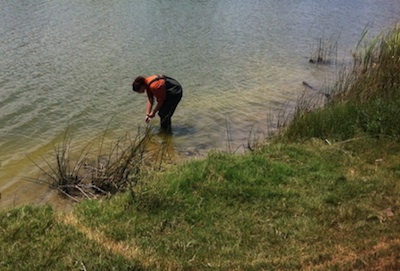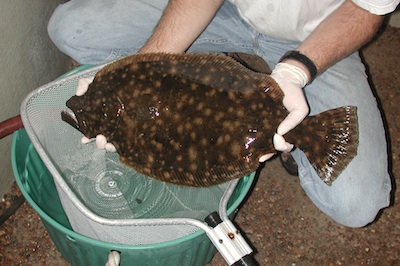Benjamin Walther analyzes the "earstones" of fish to learn where they've been, and where climate change may take them.
 Marine scientist Benjamin Walther is using Southern flounder otoliths ("earstones") such as the one pictured (in cross section) to extract information about the age and growth history of fish, much as scientists us tree rings to learn about trees. He uses laser analysis of the otolith to create a detailed record of a fish's migratory history.There’s a problem for scientists trying to understand why populations of southern flounder have been in such decline in the waters of the Texas Gulf.
Marine scientist Benjamin Walther is using Southern flounder otoliths ("earstones") such as the one pictured (in cross section) to extract information about the age and growth history of fish, much as scientists us tree rings to learn about trees. He uses laser analysis of the otolith to create a detailed record of a fish's migratory history.There’s a problem for scientists trying to understand why populations of southern flounder have been in such decline in the waters of the Texas Gulf.
“They live underwater,” says Benjamin Walther, assistant professor of marine science in the College of Natural Sciences. “We can’t just follow them from birth to death. You can tag a fish with acoustic or satellite tags when it’s an adult, but typically the young are too small and fragile. So you’re missing that whole big piece of the story. And without that there are a lot of very important ecological questions we can’t answer. That’s where otolith chemistry comes in.”
By chemically decoding the information embedded in the otoliths—“earstones”—of the southern flounder, Walther is able to discover information, about the secret lives of fish, that would otherwise remain beneath our view.
All vertebrate animals have calcium carbonate crystals in their inner ears that help in balance and orientation. In fish, the crystals form solid rock-like otoliths that happen to grow in a way that scientists like Walther can exploit. They continue to grow throughout the fish’s lifetime. They do so in layers, like tree rings, and therefore provide time-separated information. And certain elements and isotopes are incorporated into those layers that reflect the composition of the water the fish was living in.
“The otolith is like a flight data recorder,” says Walther. “It’s continually recording information from the environment, and we can use that to learn where a fish has been.”
Fisheries scientists have been using the layers in the otoliths for more than a century to gauge how old fish are and how fast they’ve grown (a layer grows faster if the fish is growing faster). In the last few decades, however, new analytical tools have enabled scientists to extract far more information from them.
 Marine science graduate student Megan Nims samples water in a South Texas estuary. Photo by A. MontalWalther has been able to make use, in particular, of the equipment at the ICP Mass Spectrometry (ICP-MS) lab in the Jackson School of Geosciences to do his analysis.
Marine science graduate student Megan Nims samples water in a South Texas estuary. Photo by A. MontalWalther has been able to make use, in particular, of the equipment at the ICP Mass Spectrometry (ICP-MS) lab in the Jackson School of Geosciences to do his analysis.
“They have all of the instrumentation and lasers to allow us to probe these structures at a fine scale,” he says. “They’ve been great to work with.”
He and his lab catch southern flounder in the waters by their home base at the college’s Marine Science Institute in Port Aransas, Texas. They collect water samples from all of the major rivers and bay systems that are part of the flounders’ habitat. They do controlled experiments to verify that certain elements in the water reliably end up in the otolith. Then they come to Austin, where they analyze the layers of the otoliths from wild fish and compare the ratios of trace elements in them to what’s found in the water samples.
When Walther was a graduate student, he and his colleagues used these techniques to create a detailed chemical map—an isoscape—that matched the traces in the otoliths of American shad to nearly every single river from Quebec down to Florida in which the species spawned.
In Walther’s investigation of the southern flounder, a project funded by the Texas Sea Grant program, the question is when in their life cycle the fish are in freshwater and saltwater environments.
This is information that as a basic scientist he simply wants to know. It’s also the kind of information that may prove useful in helping to sustain a species has been in steep decline for the last two decades, likely as a consequence of the triple whammy of climate change, overfishing and degraded estuarine habitat quality.
“The more we know about where the fish have been, the better we’ll be able to understand the relative impact of different kinds of ecological change,” says Walther, “and the better we may be able to mitigate the harm.”
When Walther began asking the question, the assumption among marine biologists was that there was a single migratory pattern that all the flounder followed. The adults spawned offshore, then went into the estuaries and settled, and then moved into freshwater for some time before they came back out to the estuarine and marine environments.
 The population of the southern flounder has been in serious decline for the last two decades, likely as a consequence of the triple whammy of climate change, overfishing and degraded estuarine habitat quality
The population of the southern flounder has been in serious decline for the last two decades, likely as a consequence of the triple whammy of climate change, overfishing and degraded estuarine habitat quality
By analyzing the ratio of barium to calcium in the layers of the flounders’ otoliths, which varies predictably according to salinity, Walther has learned that there is far more variation than was thought. Some individuals follow the stereotypical pattern. Some go into fresh water a lot, throughout their life cycles. About 40 percent never go into fresh water at all.
This variability is important ecologically for a few reasons. It may mean that the southern flounder is more resilient than it would be if it had only one migratory pattern.
“We call it the portfolio effect,” says Walther. “You spread your risk at a population level across different strategies, so if situations change at least a certain segment of your population may remain viable.”
Another reason such variability is meaningful is that, in understanding it, environmentalists and regulators can be more effective in targeting interventions.
“If you want to do spatially explicit management,” Walther says, “you would like to know things like how productive is a given micro-habitat. How connected is it to neighboring habitats? If an area is both productive and connected, if it not only is going to sustain itself but might also provide fish for a neighboring area, then that’s an area you would want to prioritize in terms of protection.”
The larger lesson, for Walther, is that there can be incredible power not just in creating general models of species behavior, but in understanding the ways that individual behavior deviates from that model.
“You want to understand the mean, but also the variation around the mean. I think that has been my guiding principle as a scientist, to characterize the variation.”

















Comments